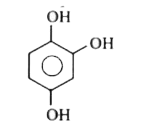The intermolecular forces of attraction (i.e., H-bonding and van der waal's forces) exist among polar and non-polar species which effect melting point, boiling point, solubility and viscosity of covalent compounds :
Q. Melting and boling points of halogen increase down the group due to
Increase in London dispersion forces
Increase in extent of polarity
Increase in Molecular mass
Both (a) and (b)
The correct Answer is:D
→ Halogens are non-polar species, hence London dipersion forces act among them and these forces are directly propotional to molecular weight.
→London dispersion forces ∝B.P and M.P in such non-polar species.
Topper's Solved these Questions
- CHEMICAL BONDING (ADVANCED)BOOK - VK JAISWALCHAPTER - CHEMICAL BONDING (ADVANCED)EXERCISE - ONE OR MORE ANSWER IS/ARE CORRECT
84 Videos
- CHEMICAL BONDING (ADVANCED)BOOK - VK JAISWALCHAPTER - CHEMICAL BONDING (ADVANCED)EXERCISE - MATCH THE COLUMN
26 Videos
- CHEMICAL BONDING (ADVANCED)BOOK - VK JAISWALCHAPTER - CHEMICAL BONDING (ADVANCED)EXERCISE - Level 2
156 Videos
- CHEMICAL BONDING (BASIC)BOOK - VK JAISWALCHAPTER - CHEMICAL BONDING (BASIC)EXERCISE - Level 3 (Passive 11)
6 Videos
Similar Questions
The intermolecular forces of attraction (i.e., H-bonding and van der waal's forces) exist among polar and non-polar species which effect melting point, boiling point, solubility and viscosity of covalent compounds :
Q. Select the incorrect order of boiling point between the following compounds:
View SolutionThe intermolecular forces of attraction (i.e., H-bonding and van der waal's forces) exist among polar and non-polar species which effect melting point, boiling point, solubility and viscosity of covalent compounds :
Q. Select the incorrect order of boiling point between the following compounds:
View Solution
Knowledge Check
The intermolecular forces of attraction (i.e., H-bonding and van der waal's forces) exist among polar and non-polar species which effect melting point, boiling point, solubility and viscosity of covalent compounds :
Q. Select the incorrect order of boiling point between the following compounds:AN2H<CH3N3BMe2SO4<H2SO4CMe3BO3<B(OH)3DBF3<BI2The intermolecular forces of attraction (i.e., H-bonding and van der waal's forces) exist among polar and non-polar species which effect melting point, boiling point, solubility and viscosity of covalent compounds :
Q. Select the incorrect order of boiling point between the following compounds:AN3H<CH3N3BMe2SO4<H2SO4CMe3BO3<B(OH)3DBF3<BI3The intermolecular forces of attraction (i.e., H-bonding and van der waal's forces) exist among polar and non-polar species which effect melting point, boiling point, solubility and viscosity of covalent compounds :
Q.The type of molecular force of attraction present in the following compounds is : AIntermolecular H-bondingBIntramolecular H-bondingCvan der waal's forceDAll of these
AIntermolecular H-bondingBIntramolecular H-bondingCvan der waal's forceDAll of these
The intermolecular forces of attraction (i.e., H-bonding and van der waal's forces) exist among polar and non-polar species which effect melting point, boiling point, solubility and viscosity of covalent compounds :
Q.The type of molecular force of attraction present in the following compounds is :
View SolutionThe intermolecular forces of attraction (i.e., H-bonding and van der waal's forces) exist among polar and non-polar species which effect melting point, boiling point, solubility and viscosity of covalent compounds :
Q.The type of molecular force of attraction present in the following compounds is :
View SolutionThe intermolecular forces of attraction (i.e., H-bonding and van der waal's forces) exist among polar and non-polar species which effect melting point, boiling point, solubility and viscosity of covalent compounds :
Q.The type of molecular force of attraction present in the following compounds is :
View SolutionIn which of the following group of periodic table melting and boiling point increase as we go down the group?
View SolutionIn periodic table, melting point/boiling point increases down the group in which of the following group ?
View Solution
